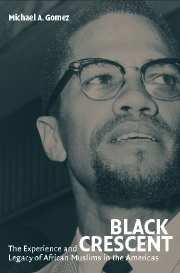Book contents
- Frontmatter
- Contents
- Acknowledgments
- Prologue
- PART ONE
- 1 Ladinos, Gelofes, and Mandingas
- 2 Caribbean Crescent
- 3 Brazilian Sambas
- 4 Muslims in New York
- 5 Founding Mothers and Fathers of a Different Sort: African Muslims in the Early North American South
- Interlude: Into a Glass Darkly – Elisive Communities
- PART TWO
- Epilogue
- Index
4 - Muslims in New York
Published online by Cambridge University Press: 05 June 2012
- Frontmatter
- Contents
- Acknowledgments
- Prologue
- PART ONE
- 1 Ladinos, Gelofes, and Mandingas
- 2 Caribbean Crescent
- 3 Brazilian Sambas
- 4 Muslims in New York
- 5 Founding Mothers and Fathers of a Different Sort: African Muslims in the Early North American South
- Interlude: Into a Glass Darkly – Elisive Communities
- PART TWO
- Epilogue
- Index
Summary
It has been demonstrated that African Muslims were already acquainted with Iberians prior to their removal to what would become Brazil and Latin America, so that what transpired between them in the New World was in a real sense a prolongation of the familiar. In latitudes much further to the north, however, the engagement of European and African, Muslim and non-Muslim alike, was much more novel an experience. This was particularly true of the territory subsequently and most famously known as New York. While meager, indirect, and deductive, the evidence for the presence of Muslims in this area remains deserving of investigation.
Englishman Henry Hudson's search for a new route to Asia, undertaken to promote the interests of the Dutch East India Company, brought him to what became the Hudson Valley in 1609. The area was called “New Netherlands” as early as 1614, but the first permanent settlement of Europeans, about thirty families of French-speaking Walloons, disembarked from the Nieu Nederlandt and established “New Amsterdam” on the island of Manhattan in 1624. The Dutch West India Company, by means of Governor Peter Minuit, “purchased” the island from “the Indians” in 1626; by 1630, some 300 Europeans, mostly Walloons, were already there. The English would seize the colony in 1664, but in the final two decades of Dutch rule the population soared to around 9,000.
- Type
- Chapter
- Information
- Black CrescentThe Experience and Legacy of African Muslims in the Americas, pp. 128 - 142Publisher: Cambridge University PressPrint publication year: 2005



